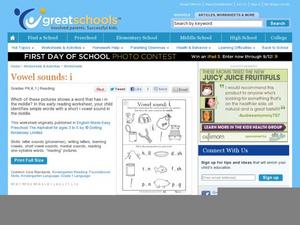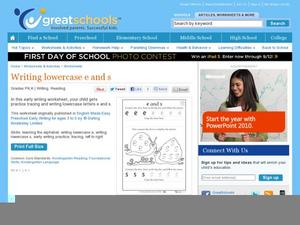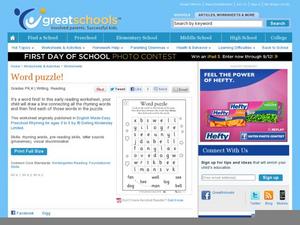Curated OER
Match the Shapes
Which shape is the same? Young geometers match a triangle, circle, rectangle, and square to their identical counterparts, connecting them with a line from left to right. Then, they do the same thing with a set of four circular shapes,...
Curated OER
x and z
Move to the end of the alphabet with some kid-friendly practice focused on the letters x and z that will inspire your scholars' artistic side. They connect the dots to trace the lowercase letters before copying them in the space...
Curated OER
p and b
Give your beginning printers some kid-friendly practice with the letters p and b that will ignite their artistic side. They connect the dots to trace the lowercase letters before copying them in the space provided. There are two pictures...
Curated OER
h and m
Make printing practice fun as scholars take on lowercase letters h and m in an artistic way. They connect the dots to trace the letters before copying them in the space provided. There is a scene they complete by tracing sets of each...
Curated OER
r and n
Here is some kid-friendly practice with the letters r and n that will ignite your scholars' artistic sides. They connect the dots to trace the lowercase letters before copying them in the space provided. There are two pictures they...
Curated OER
Vowel Sound: i
As scholars become more comfortable with initial sound correspondence, introduce them to medial sounds. As they focus on the vowel sound /i/, youngsters examine a set of images and draw a line from the letter i to any with that middle...
Curated OER
O
As part of a series of alphabet worksheets, learners focus on the letters p and o. They begin by tracing the lowercase letters, using the space to print a few on their own. Next, scholars connect the letter to images that begin with the...
Curated OER
Goldilocks and the Three Bears
Explore storyboards with your pre-reader using the familiar story "Goldilocks and the Three Bears." They look at pictures as you read the captions in a comic book style. At the end, they try to finish the story based on a resolution...
Curated OER
Odd One Out
One of these words doesn't belong! As they practice first-letter recognition, scholars examine rows of familiar objects to determine what letter each begins with. For each row of three items, they decide which does not begin with the...
Curated OER
Writing Lowercase e and s
Get familiar with the letters e and s. Two lovely snails need your class to trace the letters on their backs. After that, they can trace and then copy each letter for good measure.
Curated OER
Vowel Sounds: e
"Eh?" That is the short vowel sound the letter e makes when it is used in the middle of a word. Little ones will draw a line between the letter e and objects that make the short e sound. Then they will fill in the missing e in six...
Curated OER
Vowel Sounds: A
Say aaaaa, because today your class will be practicing the short a vowel sound. They complete two activities. First the draw a line from the letter a to the objects that contain the medial /a/ sound. Then, they fill in the missing a to...
Curated OER
Practicing Letters C and D
The lowercase letter c and d are highlighted in this two-part instructional activity. Kids complete the top half by tracing then printing the letter c and locating images that begin with the /c/ sound. Part two requires them to trace...
Curated OER
Vowel Sounds: O
This worksheet focuses on the medial vowel sound o. Pre-readers complete two tasks to practice the short o sound. They draw a line from the letter o to pictures that contain the medial /o/ sound. They then, fill in six cvc words with the...
Curated OER
Practicing Letters S and T
Let your class learn about the sounds made by the letters s and t. They work to recognize each lowercase letter and match the letter to images that begin with the /t/ or /s/ sounds. They also trace each letter several times.
Curated OER
Practicing Letters W and X
Match initial phonemes to practice recognizing the sounds made by the letters w and x. Early readers circle all of the objects that begin with either an x or a w, then trace each letter several times. Try a fun variation by having...
Curated OER
Play I Spy: In the Bathroom
Usually playing I Spy in the bathroom causes trouble, but not in this instructional activity! Little readers look for objects that begin with the letters b and t. They circle the objects in the picture, count how many of each they found,...
Curated OER
Rhyming Words: Fox and Socks
What rhymes with the word fox? Actually there are quite a few words that contain the short o vowel sound and rhyme with fox. Pre-readers find, color, and circle the objects in the picture that rhyme with the sly looking fox. They also...
Curated OER
Letters U and V
Little learners familiarize themselves with the letters u and v. They find objects in each of two pictures that begin with either v or u. They say the sound of each letter and then trace it several times.
Curated OER
Creating Letter-shape Patterns
Help your budding writers become familiar with letter shapes using a pattern worksheet. They examine three patterns, tracing a dotted line to continue them to the end of the page. For each, they also draw the pattern freehand below. This...
Curated OER
Word Puzzle
Add some fun to rhyming using a word puzzle learning exercise. First, learners match up single-syllable rhyming words. Then, they find all the words in a word search. This beginning reading activity only has words spelled horizontally...
Curated OER
Draw it Yourself
Here are four familiar pictures and words for emerging readers: dog, mouse, cat, and hen. After examining the image and spelling, they draw something that rhymes with each in the space provided. Encourage pre-readers to sound out words...
Curated OER
Missing Letters
As your youngsters begin learning to read, use visual worksheets like this to help them tie objects to words. Scholars examine six images labeled with a word. Each word is missing a first letter, and they must use one of the letters at...
Curated OER
Odd One Out
Letters q-z are the topic of the worksheet. Learners circle the picture in each row that does not make the initial letter sound indicated. They then fill in the letter that is missing from the beginning or ending of four words.

























